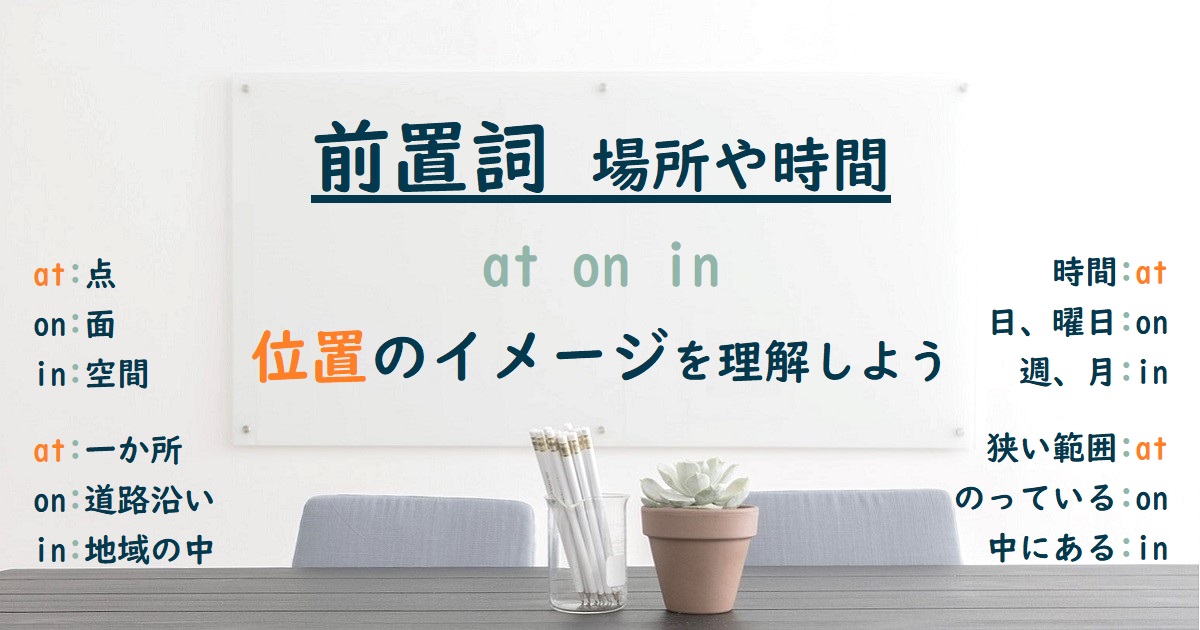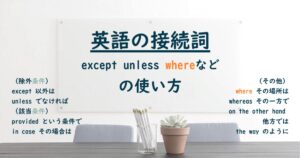場所や時間を表わす基本的な前置詞に at, on, in があります
英語の前置詞、基本は位置関係を表わすものです
そのイメージから派生して多くの状況に使われています
同じような状況で使い方を比べてみました
それぞれのイメージの違いを感じ、理解が深められることを期待します
前置詞の意味は、辞書と文法書に載っているものをベースに再分類しました
前置詞の記事の内容と例文で参考にした主なものはこちらです
場所を表わすat on in
空間の中の場所
- at 点 一つの場所
- on 面 面に接している
- in 立体 囲まれたものの中にある
基本的な使い方でイメージは和訳のとおりです
机
She is at her desk.
彼女は自分の机にいます
The book is on the desk.
本は机の上にあります
The book is in the desk.
本は机の中にあります
部屋
There is somebody at the door.
ドアの前に誰かいる
There is a notice on the door.
ドアに貼り紙がある
There is somebody in the room.
部屋の中に誰かいる
家
I’m at home.
自宅にいる
I’m on the second floor of my house.
自宅の2階にいる
I’m in my house.
自分の家にいる
建物
I’ll meet you at the entrance to the hotel.
ホテルの入り口で会いましょう
I’ll meet you in the lobby on the second floor of the hotel.
ホテル2階のロビーで会いましょう
所在地
地図のような2次元で表せるものの位置では次のようになります
- at 特定の位置 駅、店など
- on 線に沿った場所 道路沿い、川沿い、海岸沿いなど
- in 囲まれた範囲 地域の中、川の中、湖の中など
所在地
She is at the cafe on the Gold Coast.
彼女はゴールドコーストの喫茶店にいます
I’m on the coast, so I can swim in the sea anytime.
海岸にいるので、いつでも海で泳げます
See you at Harajuku station.
原宿駅でお会いしましょう
I’m at the Shibuya Crossing in Shibuya.
私は渋谷のあの交差点にいます
The shop is on Takeshita Street in Shibuya.
お店は渋谷の竹下通りにあります
The hotel is on a small island in the middle of a lake.
そのホテルは湖の真ん中の小さな島にある
列や集団
Let’s sit at the front of the cinema.
映画館の前のほうに座ろう
Let’s sit on the left side of the cinema.
映画館の左側に座ろう
When I go to the cinema, I like to sit in the front row.
映画館に行くときは、最前列に座るのが好きなんだ
We drive on the left, but we walk on the right.
運転は左側を通りますが、歩くのは右側です
They’re standing in a row.
彼らは一列に並んでいます
その他の位置
I’m at the end of the street.
道路の突当りにいます
We stopped at a shop on the way home.
帰りにお店に立ち寄りました
They kissed in front of the tower.
彼らはタワーの前でキスをしていた
場所、所在地での使い分け一覧
空間や所在地での使い分けは次のようになります
空間の場所
| at:一か所 | on:何かの上 | in:空間の中 |
|---|---|---|
| at the table at my desk at the door | on the table on the sofa on the roof | in the room in a box in the bag |
| 家庭 | 階 | 家 |
| at home at work | on the first floor on the fifth floor | in my house in the office |
所在地
| at:一か所 | on:線状のもの沿い | in:広がりの中 |
|---|---|---|
| at the cafe at the bakery | on a river(川沿い) on the street | in a river(川の中) in the sea |
| at the school in the library | on the coast on the beach | in the waiting room in the swimming pool |
| at Sibuya station at the crossroads | on the platform on Takeshita Street | in Shibuya in Europe |
| at that adress | on the island | in the alps in the world |
集団の中の位置など
| at:先頭、端など | on:左右など | in:列の中など |
|---|---|---|
| at the front at the top of at the bottom of | on the left on the right on the right side | in a row in a line in the middle |
| at the end of the street | on the way home | in front of the station |
| at the corner of a street (通りの角) | on the corner of a street (通りの角:atと同じ) | in the corner of the room (部屋の中の角) |
時間を表わすat on in
日付や時間
- at 一点 時間、イベント
- on 一日 日付、曜日
- in 期間 午前中、週間、月、年
時間、日、月
They arrived at 5 pm.
午後5時に到着しました
They arrived on Friday.
金曜日に到着しました
They arrived in July.
7月に到着しました
朝食、夕食
we were talking about this at breakfast.
私たちは朝食時にこのことについて話していました
he said at dinner on Wednesday night, that…
彼は水曜日の夜の夕食時に次のように言った、…
クリスマス、クリスマスの日
I got an email at Christmas.
クリスマスにメールが来た
He gave me a big present on Christmas Day.
彼はクリスマスの日に大きなプレゼントをくれました
同じクリスマスでも食事のような一つのイベントと考えるか1日と考えるかの違いでしょうか?
週末
週末にはここに来ますか?
Will you be here at the weekends?
(イギリス英語)
Will you be here on the weekends?
(アメリカ英語)
週末はイギリスとアメリカでとらえ方が違っています
複数形にしないで weekend でも大丈夫です
週、午前中
They arrived in this week.
今週到着しました
They arrived in the morning.
午前中に到着しました
1週間だと日付ではなく長い期間のイメージになります
午前中は、日本語でも「中」というように一定の期間をイメージしていますね
(on)
You could see them on the evening news.
夕方のニュースで見ることができました
On the evening of Monday, he will fly to Hawaii.
月曜日の夕方、彼はハワイに飛ぶ予定だ
(in)
In the evening, she usually walks her dog.
夕方は、ふつう犬を散歩に連れていく
you can always come over in the evening to have a drink.
夜にいつでも飲みに来てください
この辺りの感覚は長い期間(in)なのか、一区切りの期間(on)なのかイメージしずらいところです
(on time)
Please be on time.
時間通りに来てください
The 11:45 train left on time.
11時45分の電車は定刻通り出発した
(in time)
Will you be home in time for dinner?
夕食までには家に着きますか
We got to the station just in time for our train.
駅に着いたのは、電車の時間ギリギリでした
on time:時間ピッタリ
in time:(soon enough)間に合うように
just in time:ギリギリ
※ちょうどいい時間は in time のようです
The kids will be home in an hour.
子供たちは1時間以内に帰ってくるだろう
We have to be home by 5:00.
5時までに帰らないといけない
I’ll be working until 11:00.
11時まで仕事が続きます
それぞれのイメージは次の通りです
- in :時間以内でちょうどいい時間
- by :期限でそれまでの期間のいつか
- until :その時まで続いている
時間での使い分け一覧
時間、日付などでの使い分けは次のようになります
| at:時間、イベント | on:日、曜日 | in:日、曜日 |
|---|---|---|
| at 3 am | on July 30 | in July |
| at noon at night | on Friday on Tuesday | in 2020 in the 21st century |
| at midday at midnight | on the weekend (at the weekend) | in the morning in the evening |
| at Easter at Christmas | on your birthday on Christmas day | in the week in the summer |
| at dinner at breakfast | on a cold day on independence day | in the past in the future |
| at the moment at the minute | on anautumn evening on the evening of July 5 | in an hour in five minutes |
| at that time (その時間) | on time (時間通り) | in time (時間以内) |
抽象的な概念で使うat on in
点、上、中をイメージするもの
- at 点 一か所
- on 上 のっている
- in 中 中にある
乗り物
He got on a plane anyway.
とにかく彼は飛行機に乗った
So I was forced to get on the bike.
それで仕方なく自転車に乗った
Let’s all get in the car.
みんなで車に乗りましょう
on は上に乗るものや立って乗り込む、in は座るのような解釈がありました
on は公共(運んでもらう) in は個人(運転手との関係が近い)のような解釈もありました
公共機関は空間の中に入るのではなく、上に乗って運んでもらうイメージなのかもしれません
プライベートジェット(private jet)は on と in のどちらがふさわしいのでしょう?
あなたはどちらがお好みですか?YouGlish で調べてみると半々ぐらいで両方とも使われていました
Google Ngram で調べてみると、当初は半々ぐらいでしたが最近は on が多く使われています
その状況から見ると、今後は on が主流になりそうです
小さいサイズで中に乗り込むイメージから、大型サイズで上に乗るイメージになったのかもしれません
イベント、メディア
I was at a concert.
コンサートに行っていました
His mother saw him on TV.
彼の母親は彼がテレビに映っているのを見ました
That’s what we read on a website, saw in a tweet.
それは私たちがウェブサイトで読んだことやツイートで見たことです
Who is the woman in that picture?
写真の中の女性は誰なの?
イメージは次の通り
at:イベントは一つの場所
on:メディアは電波に乗っている
in:印刷物は中に書かれている
ツイート(tweet)は in a tweet のように in が多く使われています
YouGlish で調べてみると on a tweet のように on を使っている人も少しいました
in が主流派だったので、メディアに乗っているのではなく書いているものの中と考えているようです
本
I wrote about it in a book.
それについて本に書きました
You can actually read it on the page.
実際にページ上で読むことができます
It should be at the top of the page.
ページの先頭にあるはずです
本の中、ページ上、先頭の位置のようなイメージが合います
学校
She is at school.
学校に行っている
She is in school.
在学中です(アメリカ英語:GIU)
冠詞がない schoolは場所ではなく「勉強すること」のような意味で使われています
at は学校で勉強中、in は在学中のイメージです
イギリス英語では、at school を在学中の意味でも使います
Something that looks good at first, in the end it could break.
最初は良く見えても、最終的には壊れる可能性があります
at first の対義語は in the end になります(GIU)
いろいろな使い方を集めました
(a book)
I looked at a book from the 1480’s.
1480年代の本を見ました
I’m working on a book right now.
今、本を執筆中です
Would you consider collaborating on a book with another author?
他の著者と本でコラボすることを検討してみませんか?
(be based:拠点を置く)
I’m based at the head office.
私は本社勤務です
This part was based at the University of Melbourne.
この部分はメルボルン大学に拠点を置いています
This team is based in Paris.
このチームはパリに本拠地を置いています
He is based in North Carolina.
彼はノースカロライナに拠点を置いています
This project is based at Utah State right here.
このプロジェクトはここユタ州に拠点を置いています
be based が「拠点を置く」の意味では、本社や大学などでは at、地名では in が一般的です
例外もあり、最後の例のように話し手が一つの場所と感じればユタ州でも at を使っています
(be based:基づく)
This movie is based on a true story.
この映画は実話に基づいています
Art is based in fear.
芸術は恐怖に基づいています
be based は on もありますが、「基づいて」の意味になります
この意味では on が一般的ですが、状況により in も使われていました
She left in a hurry on a errand.
彼女は用事で急いで出発した
Public Library established in her name.
彼女の名前で公共図書館が設立されました
位置の概念と結びつけて考えると理解が深まります
これらが共通認識として使われているので、ネイティブ感覚に慣れるしかないでしょう
抽象的な概念での使い分け一覧
交通機関
| at:(場所) | on:公共 立って乗り込む | in:個人 行き先が自由 |
|---|---|---|
| at the bus stop at the station | on the bus on the train | in the car in a taxi |
| on the bike on a horse | in a camper in his private jet* |
イベント、メディア
| at:イベント | on:メディア | in:印刷物 |
|---|---|---|
| at a party at a concert | on TV on the phone | in a book in the newspaper |
| at the cimema | on the screen on the Internet | in a picture in a tweet* |
その他
| at | on | in |
|---|---|---|
| at the top of the page | on the page on the menu | in a book |
| at school at home at work | in school in bed in hospoital | |
| at the meeting | on a book | in my pocket in the red suit |
| at first (最初は) | in the end (finally)最後は |
おわりに
最初にも書きましたが、いろいろな例文でそれぞれのイメージの違いを理解することが重要です
抽象的なものは位置のイメージから派生しています
ネイティブが抱くイメージを理解すれば前置詞をより正しく使えます
日本語の「てにをは」と似ています
意味を考えなくても、語感で使えるようになるといいですね











